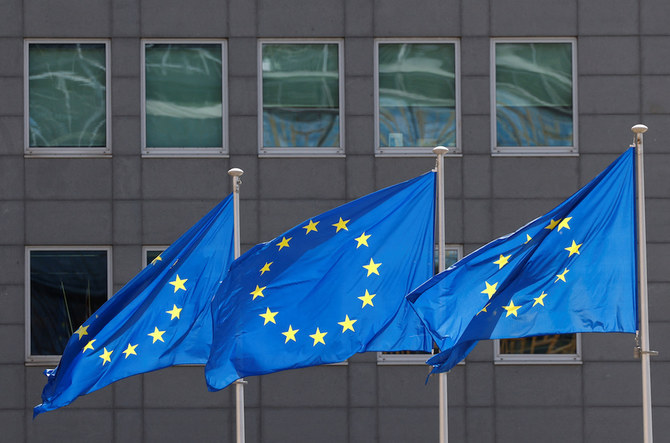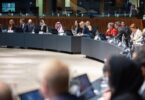Andrew Hammond
Latin America has previously been called the “lost” or “forgotten” continent, yet it is now assuming a much higher strategic importance, especially in the wake of Russia’s invasion of Ukraine.
For decades, the region was often overlooked by some key Western powers — especially much of Europe — given that its economic growth generally was not as fast as that of Asian emerging markets, while its poverty was not as great as that in much of Africa.
Yet since the war in Ukraine began, European attention has quickly turned to this vast continent, which is home to half a billion people, the world’s largest reserves of arable land, plus huge amounts of wider resources, including critical minerals and the largest share of renewables in the world.
Last month, UK Foreign Secretary James Cleverly gave a speech in Chile in which he argued that the “tectonic plates of world politics are shifting once again,” with “Latin America’s demographic and economic weight … giving more voice and more influence.”
Specifically, he called for Brazil to be given a permanent seat on the UN Security Council, and argued that the UK is the region’s “oldest friend,” some two centuries after bilateral ties were first established.
However, it is the EU that might be warming its ties with Latin America at the fastest pace. Similarly to authorities in the UK, key figures across the 27-member bloc recognize the region’s huge future potential. The EU’s foreign policy chief, Josep Borrell, even said last month that this emerging market has the potential to become the Arabian Gulf, given its critical mineral assets, such as lithium.
This growing importance of Latin America to Europe was also showcased in the EU’s new Global Gateway strategy. And also by the major, intensified push to finally secure a trade deal between the EU and Mercosur, the Southern Common Market, creating a combined market of about 720 million people.
The EU’s flagship Global Gateway strategy is mobilizing up to €300 billion ($328 billion) of investment globally for sustainable, high-quality projects between 2021 and 2027 in areas such as the green and digital transition, transport and energy infrastructure, health, education, skills and research, and sustainable finance.
Examples of projects that the EU is embedding in Latin America, specifically, as part of the strategy include critical raw material value chains for lithium and copper, green hydrogen production, and the expansion of electricity transmission networks.
Building on the strategy, the EU is also making a big push for a trade deal with the Mercosur bloc: Brazil, Argentina, Uruguay and Paraguay. This has been agreed in principle but efforts to finalize it have been frozen. The trigger for the current intensified push to get it concluded is not only that Europe knows it urgently needs to diversify its trade links and become less dependent on Russia and China for its raw material value chains. In addition, the departure of controversial Jair Bolsonaro from the Brazilian presidency at the end of last year has added to the political “window of opportunity” to get a deal over the finish line.
During her major official visit to Latin America last week, European Commission President Ursula von der Leyen pledged along with Brazil’s President Luiz Inacio Lula da Silva and Argentina’s President Alberto Fernandez that the Mercosur deal will be concluded by the end of this year. This echoes calls from other senior European politicians, including German Chancellor Olaf Scholz, who said during a trip to Argentina last year that “the negotiations have now lasted long enough” and he and other EU partners want the agreement to be ratified in 2023.
The EU-Mercosur agreement has been in the making for more than two decades, during which two-way trade has increased even without a finalized deal, and both sides want the talks expedited ahead of a key EU-Latin America summit on July 17-18. While the agreement was officially concluded in 2019, both sides are still advocating for additional clauses.
This might sound straightforward. However, there is a danger it could result in previous, carefully negotiated economic trade-offs within the wider deal being reopened, which risks causing more delays.
For instance, Lula has said: “I have faith that we will announce this Mercosur agreement soon but with better quality to ensure that Latin American countries can have an industrial policy.”
He wants to reorient the trade relationship with the EU away from the prospect of Brazil simply being a giant agricultural powerhouse for European consumers, and reopen negotiations to add provisions relating to reindustrialization, technology transfer, and wider issues such as human rights.
On the European side, the two main sets of concerns center around agriculture — a key concern for France, which is Europe’s largest producer in this sector — and Brazil’s commitments to tackle deforestation.
On the latter issue, several EU countries, members of the European Parliament, and activists have expressed grave concerns about the fate of the Amazon rainforest, and the European Commission is negotiating additional text in the agreement with Mercosur that would include more sustainability commitments.
EU trade negotiators last year presented an additional document to the Mercosur countries to try to assuage concerns in Europe about these issues, especially deforestation in the Amazon. The European Commission hopes this additional instrument will avert the need to completely reopen the wider trade agreement.
Taken together, this is why a window of opportunity might now exist to get the trade deal over the line before next year’s EU election campaigning begins, thereby cementing the deepening of ties between the two regional powers.
However, if an agreement cannot be concluded in the next six months, it might well get pushed out beyond next year, given that the next European Commission, which will come to power in the second half of 2024, will require time to settle in and start delivering on its priorities.







